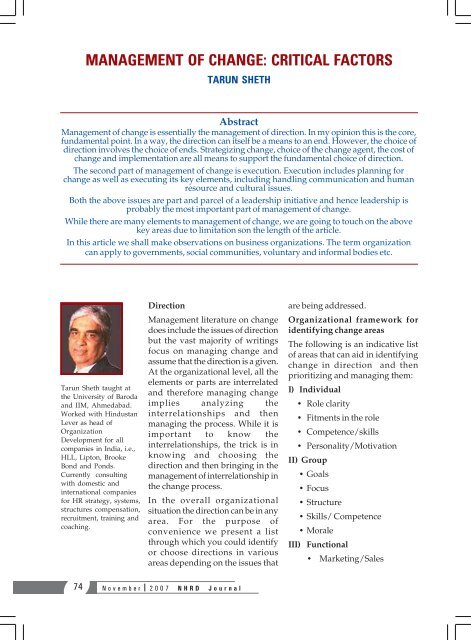NHRD Journal - National HRD Network
NHRD Journal - National HRD Network
NHRD Journal - National HRD Network
You also want an ePaper? Increase the reach of your titles
YUMPU automatically turns print PDFs into web optimized ePapers that Google loves.
MANAGEMENT OF CHANGE: CRITICAL FACTORS<br />
TARUN SHETH<br />
Abstract<br />
Management of change is essentially the management of direction. In my opinion this is the core,<br />
fundamental point. In a way, the direction can itself be a means to an end. However, the choice of<br />
direction involves the choice of ends. Strategizing change, choice of the change agent, the cost of<br />
change and implementation are all means to support the fundamental choice of direction.<br />
The second part of management of change is execution. Execution includes planning for<br />
change as well as executing its key elements, including handling communication and human<br />
resource and cultural issues.<br />
Both the above issues are part and parcel of a leadership initiative and hence leadership is<br />
probably the most important part of management of change.<br />
While there are many elements to management of change, we are going to touch on the above<br />
key areas due to limitation son the length of the article.<br />
In this article we shall make observations on business organizations. The term organization<br />
can apply to governments, social communities, voluntary and informal bodies etc.<br />
Tarun Sheth taught at<br />
the University of Baroda<br />
and IIM, Ahmedabad.<br />
Worked with Hindustan<br />
Lever as head of<br />
Organization<br />
Development for all<br />
companies in India, i.e.,<br />
HLL, Lipton, Brooke<br />
Bond and Ponds.<br />
Currently consulting<br />
with domestic and<br />
international companies<br />
for HR strategy, systems,<br />
structures compensation,<br />
recruitment, training and<br />
coaching.<br />
Direction<br />
Management literature on change<br />
does include the issues of direction<br />
but the vast majority of writings<br />
focus on managing change and<br />
assume that the direction is a given.<br />
At the organizational level, all the<br />
elements or parts are interrelated<br />
and therefore managing change<br />
implies analyzing the<br />
interrelationships and then<br />
managing the process. While it is<br />
important to know the<br />
interrelationships, the trick is in<br />
knowing and choosing the<br />
direction and then bringing in the<br />
management of interrelationship in<br />
the change process.<br />
In the overall organizational<br />
situation the direction can be in any<br />
area. For the purpose of<br />
convenience we present a list<br />
through which you could identify<br />
or choose directions in various<br />
areas depending on the issues that<br />
are being addressed.<br />
Organizational framework for<br />
identifying change areas<br />
The following is an indicative list<br />
of areas that can aid in identifying<br />
change in direction and then<br />
prioritizing and managing them:<br />
I) Individual<br />
• Role clarity<br />
• Fitments in the role<br />
• Competence/skills<br />
• Personality/Motivation<br />
II) Group<br />
• Goals<br />
• Focus<br />
• Structure<br />
• Skills/ Competence<br />
• Morale<br />
III) Functional<br />
• Marketing/Sales<br />
74<br />
November 2007 <strong>N<strong>HRD</strong></strong> <strong>Journal</strong>
















